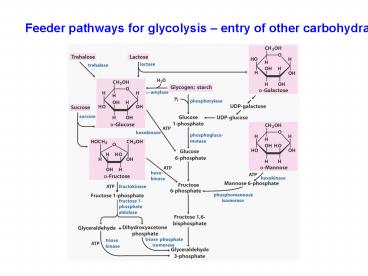Feeder pathways for glycolysis entry of other carbohydrates - PowerPoint PPT Presentation
1 / 15
Title:
Feeder pathways for glycolysis entry of other carbohydrates
Description:
Amylase reaction is. similar except attack. is by water, and. generates ... Amylase as an alternative. pathway to mobilize glycogen. Interconversion of G1P and ... – PowerPoint PPT presentation
Number of Views:1473
Avg rating:3.0/5.0
Title: Feeder pathways for glycolysis entry of other carbohydrates
1
Feeder pathways for glycolysis entry of other
carbohydrates
2
Glycogen and starch similar but glycogen more
highly branched
Structures of starch and glycogen
polysaccharides. Enzymatic removal for entry of
monomers into glycolysis is from the
nonreducing end. The reducing end is oxidized
in reactions to reduce Cu2 and quantitate sugar
concentration (eg, in blood)
3
- Highly regulated step
- Glycosidic bond energy
- conserved
- Amylase reaction is
- similar except attack
- is by water, and
- generates di- and tri-
- saccharides that are
- further hydrolyzed
- by other enzymes.
4
Feeder pathways for glycolysis entry of other
carbohydrates
dietary disaccharides (epithelial cell surface)
hydrolysis
phosphorolysis
5
Feeder pathways for glycolysis entry of other
carbohydrates
- Amylase as an alternative
- pathway to mobilize glycogen
- Interconversion of G1P and
- G6P is by a mutase (recall
- phosphoglycerate mutase
- at step 8 of glycolysis)
- Specific enzymes exist to
- convert disaccharides to
- monosaccharides
- Fructose enters by two
- different pathways in muscle
- (hexokinase) and liver
- (fructokinase aldolase
- triose kinase)
6
- DHAP is interconverted with G3P to enter
glycolysis via TIM reaction - Glyceraldehyde is phosphorylated by another
enzyme triose kinase, by - coupling to ATP hydrolysis
- Thus both products of F1P aldolase convert to
G3P, converging with - glycolysis from glucose.
7
UDP-galactose is formed when
galactose-1-phosphate displaces
glucose-1-phosphate from UDP-glucose.
- first oxidation by epimerase,then reduction,
- inverting the configuration at C4,
- (as required to convert galactose to glucose)
- (recall that epimers differ at one chiral center)
- Net outcome of pathway Glu-1-P made from Gal-1-P
- No net change in UDP nucleotides or in NAD
X
8
(No Transcript)
9
(No Transcript)
10
Oxidation needs NAD
This is NAD exchange, Not redox reaction
Can consider that thiolate forms first, then
proton transfer
11
In glycolysis, glyceraldehyde-3-phosphate
dehydrogenase requires NAD to oxidize G3P In
aerobic metabolism, the NAD is regenerated in
the electron transport chain (electrons pass
from NADH to other carriers) In anaerobic
metabolism (early earth) NAD has to be
regenerated in some other way LDH An example
of fermentation energy is extracted from sugar
and stored as ATP, but there is no net change
in the oxidation state of the sugar.
G3PDH
LDH
12
Ethanol fermentation starts from pyruvate
CO2 production. Makes the resulting mixture
carbonated (beer), or causes dough to rise
(bakers yeast) Pyruvate decarboxylase absent
in organisms (human) that carry out lactate
fermentation Alcohol dehydrogenase present to
allow metabolism of EtOH (reverse oxidation
reaction)
13
-cleavage of C-C bonds adjacent to carbonyl
groups -transfer of activated acetaldehyde to
other groups
14
(No Transcript)
15
- Fermentation to ethanol is a source of biofuels
- Supplement to gasoline
- Viable renewable energy technology if proper
feedstock































